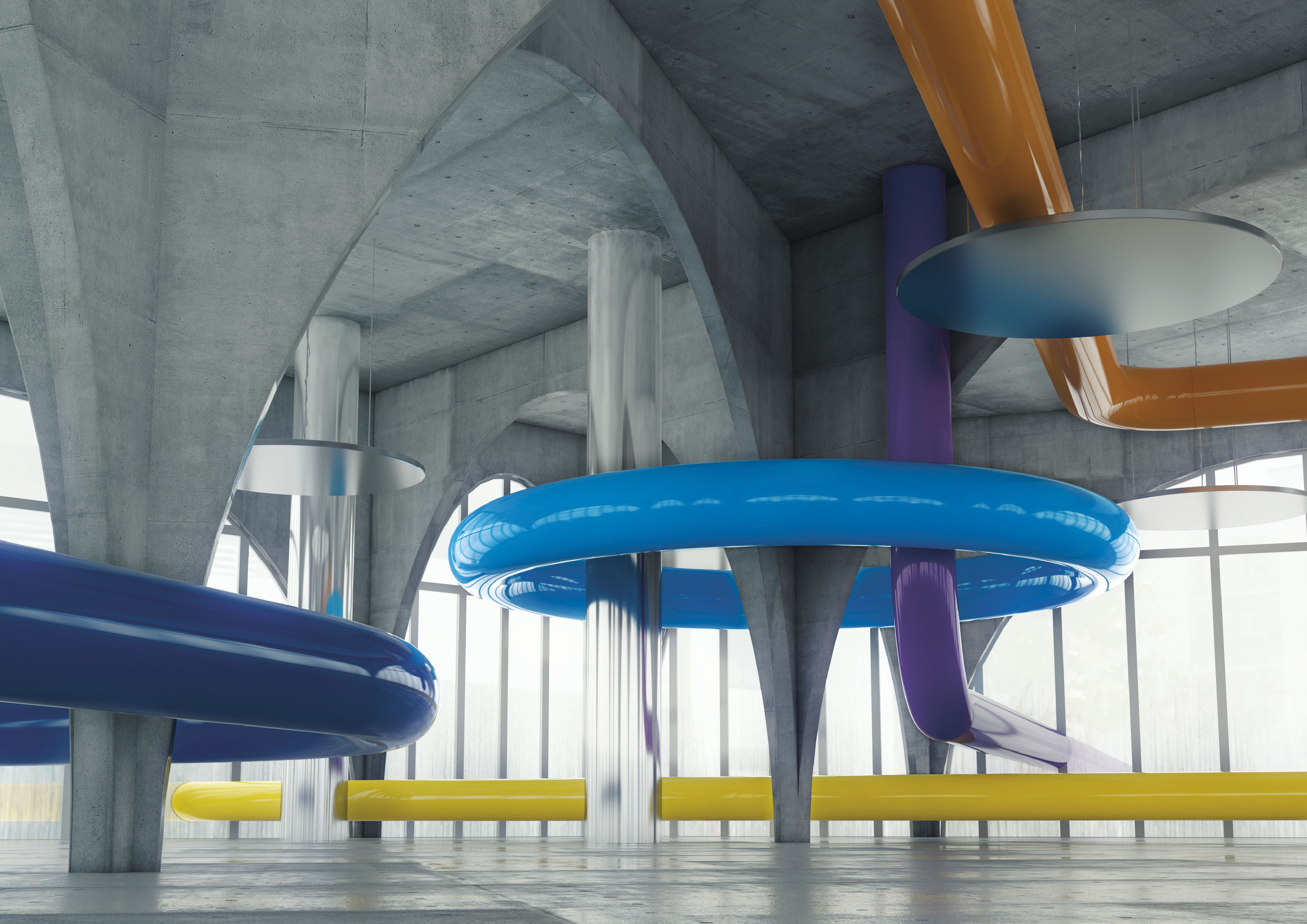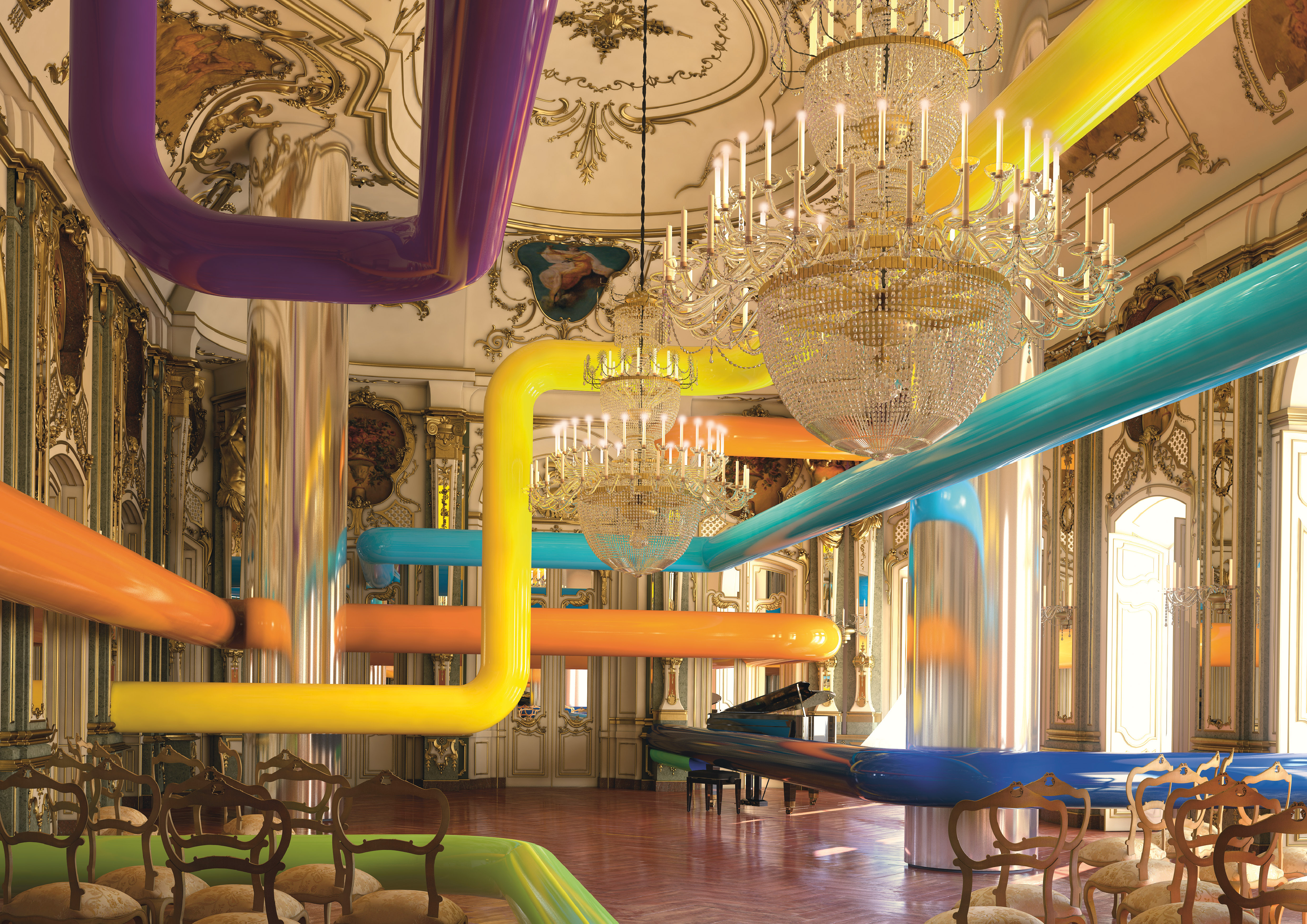
Mirrored columns, walls in colours from the far ends of the spectrum and massive pipes dominate the space. The sheer presence and sleekness of these objects gives off such a strong sense of normality that there seems to be no need to probe their function further. The question of how far computer programmes are able to reproduce and simulate reality has been an important issue from at least 1984 when experiments were conducted at Cornell University. Their goal was to create accurate virtual replicas of spaces for graphics, game design, architecture and construction design. Using a real three-dimensional model, the “Cornell box”, physical phenomena such as refraction, shadow, mirror images and reflection were observed and then reconstructed digitally. Light rays traced coloured walls, mirrors and placed objects (Ray tracing), enabling them to be rendered accurately. Whilst this series of experiments that shaped our future tested the possibility of creating digital simulations to emulate reality, Manuel Roßner’s installation Ultralight Beam recreates the virtual world in the real world, thereby bringing not only the logic but also the aesthetics of computer programmes into an actual walk-in space. Industrial buildings and pipe systems can be constructed in 3D infrastructure software. Different colours are used to help us find our way round the three-dimensional plans and indicate the diameter of the pipes. When we see these garishly coloured pipes running through an equally brightly coloured room, we are reminded of a glorious children’s playground, but they can actually be traced back to the functionality of the programme.
At first, what seems to be at work here is Vilém Flusser’s basic principle: “The more beautiful the digital image, the more real and truthful the projected alternative worlds.”1 But then a moment later, digital functionalism seems to dominate. With Flusser, the alternative worlds are just as real as the one we have — or the one we have is just as eerie as the alternatives. Roßner no longer distinguishes between the real world and the alternative world, but experiences space simultaneously as a physical dimension, virtual image and hyperreal medium. What is more, these categories completely dissolve, very much in line with Baudrillard’s simulacra, which has rendered the divergence between original and copy, model and replica, reality and imagination obsolete since the advent of the mass media and even more so the digital media.

Photo: Neven Allgeier
For Roßner, this development, which continues to gather pace, is not a dystopia that will overtake mankind with its bleak vision of the future, rendering us useless, or even dehumanising us. Rather, he sees it as a liberating power in neoliberalism. Machines doing the work of people have not only been a feature of many a science fiction story since time immemorial but have actually been a reality in our society since the industrial revolution. The new technologies offering the promise of salvation from our capitalist structures? In their post-capitalist manifesto Inventing the Future, Nick Srnicek and Alex Williams outline the liberating potential of high-tech: “Demand full automation, demand a universal basic income, demand the future.”
The manpower provided by machines allows man to reclaim more and more of the time he has sacrificed to the neoliberal world of work, to reallocate it on a personal basis and to renounce precarious employment conditions. Critics may reproach this approach with the fact that the automation we are striving for will not give us self-determination, as it is often precisely this fetishised technology that creates and steers our desires.
However, today’s technological infrastructure gives us resources that actually have the potential to realise the demands of the left for redistribution of wealth, equality, freedom and self-determination — from the internet and social media to 3D printing and open source design, from renewable energies and advances in medicine to computer simulations that benefit the economy. Yet this potential is not being exploited, but clings to an outdated understanding of technology and the all-consuming principle of capitalism.
For Roßner’s way of working, self-determination means enlightenment, knowledge transfer, participation and transparency. He develops his artistic practice from the pool of what is possible, using the tools and space available to him. Playful but always with a connection to the physcial world. And in this case, we can see the real in both: in the analogue and the digital reality. In Roßner’s Ultralight Beam, behind “the beautiful digital illusion” there is also a beautiful techutopia hidden.





